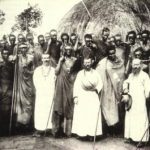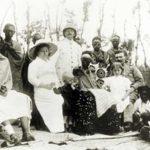I. Teminology
Feudalism.The loose use of the feudal model applied to African societies has come in for considerable criticism, and its use in this book requires some justification. The first major criticism came from E M. Chilver in Audrey Richards’s East African Chiefs.Redmayne, in a major discussion of the topic, suggested that comparisons with other African societies might be more fruitful than the slavish application of European terminology. Goody wanted analysis ‘with less worn counters, with more operational concepts’ than feudalism. Beattie came to reject the concept of feudality as inadequate as a description of Nyoro society. De Heusch, following Mair, preferred to place feuclalism in the broader category of clientship States. The most telling part of Goody’s argument was the disparity between the raised value of land in Europe, created by feudal technology, and the low-yield land of Africa, where labour is at a premium; African technology would be too underdeveloped and land too poor to sustain feudalism.
Two major distinctions are made in these critiques: on the one hand feudalism as `feudo-vassalage’ in the socio-legal sense of Maitland and Pollock, described by Ganshof as ‘a body of institutions regulating the obligations of obedience and service — mainly military service — on the part of the free man (the vassal), towards another free man (the lord), and the obligations of protection and maintainance on the part of the lord with regard to his vassal. On the other hand there is the more comprehensive `feudal society’, a political and governmental category characterised by a type of land holding, legal system, decentralisation of authority, and relationship between king and
nobility. Feudalism in this second sense is normally presented as a process model drawn from the sequence of historical changes in Western Europe from the ninth to the thirteenth centuries. Thus feudalisrn arises as the resuft of the breakdown of an empire and gives rise to powerful kingships, not through the growing power of the king’s men but by the monarch establishing himself at the head of a pyramid of feudal lords.
The use of the comprehensive definition, even abstracted to the level of a process model, effectively precludes all debate, as Beattie’s discussion of Nyoro kingship demonstrates. It is clear that the European sequence of political processes has not repeated itself in Africa; the feudal model in the African context is used as an explanation of state formation, not as a description of disintegrated States and empires. Kagame is typical in this respect in that he refuses to use the word ‘feudal for Rwanda because the nineteenth century was characterised by the growth of an absolute monarchy. He however, like Maquet, use the word in the limited socio-legal sense for the ‘contrat de servage’, ubuhake.Much of this debate has centred round the interlacustrine kingdoms that ended up as British colonies and the focus of anglophone historical study. Kagame alone was in print at any early date on Belgian Rwanda, and his position is obviously coloured by the pejorative overtones of the term ‘feudal’in post-war Rwanda. The recent French Marxist school of African historians, of course, has found no difficulty in applying feudal terminology to Rwanda and Burundi.
There is certainly no problem with the limited use of the term feudal as ‘feudo-vassalage’. In the second half of the nineteenth century central Rwanda became a complex pyramid of clientship ties headed by the king; the early type of vassalage was military service in the ngabo, and a military class grew up, not on the basis of ownership of equipment, horses and weapons, but as the product of lengthy training in the itorero. A garagu passed through a formal rite of subordination and exchanged service for protection, while the relationship was recorded by a benefice of movable property over which the garagu had usufruct rights (fief comes originally from vieh, cow, even in the European context).
Nor are many of the criticisms levelled at the comprehensive model valid for Rwanda. Chilver’s insistence on land holding being strictly and legally tied to political office in a simple cause-and-effect relationship, with the incumbent movable at the king’s behest, is both static and Eurocentric in the extreme, and begs the question of whether there is an overall de facto connection between political office, clientship and land holding. There certainly was in Rwanda.
Ces deux structures politiques et l’institution de clientèle étaient corrélatives. Les fonctions politiques aidaient les Tutsi à accroître le nombre de leurs clients, et la structure de clientèle leur permettait d’obtenir des fonctions politiques et de les conserver. Les relations entre le seigneur et le client constituaient un modèle pour les relations entre les gouvernants et leurs sujets.
As D’Hertefelt points out, powerful landowners and patrons represented in microcosm the political power of the State as a coercive organ of the ruling class. Political office allowed a powerful man to extend his land holding as clients alienated land for protection, and to gain clients as the weak escaped the threat of expulsion in personal relationships.
The Goody critique also needs to be looked at carefully in the context of Rwanda, where there was considerable land shortage in some provinces by the 1950s. The kingdom was only about 100,000 square miles and had to support a leisured class of some 2,000 chiefs and about 50,000 Tutsi who never tilled the soil. The high produictivity of the land, well manured by cattle, with bananas and a wide range of grains and leguminous crops, made land valuable, especially when large tracts served as posture for the Tutsi herds. While they could not match the feudal technology of Europe, Rwanda’s direct producers did provide surplus labour to sustain a small class of leisured lords. The existence of a class of landless labourers in the nineteenth century would also have ‘stoked the fires of land hunger and given force to the right of exclusion’.
What both European and Rwandan feudal societies had in common was an internal tendency towards an equilibrium in which a military aristocracy ruled through a chain of clientship relations checked on one side by the monarchy, the king’s men, and on the other by lineages and clans. Both twelfth century England and nineteenth century Rwanda were marked by the dominance of ideology and political power over society. But it is also clear — and here the level of abstraction of the French Marxist school helps to prescind front many difficulties — that the particular texture of society which these two States had in common was the product of a mode of production in which a class of lords controlled land and labour. The dominance of ideology and political power in Rwanda’s colonial history, the central theme of this book, finds its rationale in Rwanda’s feudal mode of production.
The advantage of the use of a feudal model for Rwanda is simple: changes in society after the 1930s can be understood as part of a process in which the insertion of the capitalist cash economy into a feudal mode of production is intimately connected with colonial tampering with political structures and more indirectly related to changes in the ideology of the Mission Church. This insight can be gained only by allowing the degree of abstraction involved in the use of feudal terminology. The use of feudal terms does not, of course, imply the existence of homologous structures in Europe and Africa any more than the use of terms like ‘State’ and ‘army’ assume exactly comparable institutions.
Caste, clans or ethnic group. Some of the difficulty encountered in using feudal terminology recurs in giving an adequate account of Rwanda’s social stratification. ‘Caste’ inevitably carries with it religious overtones from India that are incongruous in the Rwandan context. Furthermore, D’Hertefelt’s work on the multi-class nature of Rwandan clans has demonstrated that much intermarriage occurred in the past, and denies an essential aspect of ‘caste’.
‘Ethnicity’ is a way of perceiving socio-economic differences and can hardly be used as an objective description of the differences between Tutsi, Hutu and Twa. It was common in Europe for the nobility of a supposedly racially homogeneous society to emphasise ‘Noble blood’ and ‘aristocratie features’, in short to present class differences as if they had biological bases. I will therefore prescind from the question of the genetic differences between Tutsi, Hutu and Twa, since these are of no operational significance. In the colonial period, when access to political office was limited to the Tutsi, defined by the Belgians as an ethnic group, the disparity between the perceived divisions in society and the real divisions becomes most marked; at this point it will be necessary to discuss ‘ethnicity’ as a component in Tutsi ideology.
Therefore ‘class’ is used in the text, defined in a way applicable to pre-capitalist formations as a group of people having the same relationship to the mode of production. The Hutu are therefore a class in as much as they are direct agricultural producers in a feudal mode of production. The Tutsi are a class in as much as they appropriate surplus labour in the same mode of production. But, since the feudal economy was limited to central Rwanda, albeit extended by colonial rule, these ‘classes’ do not apply to all of the country. The isolated Tutsi households of the north were simple cattle-herders in an exchange relationship with Hutu farmers. In such regions production was dominated by kinship. While it is possible to assert, as does D’Hertefelt, that by the end of the colonial period all Tutsi shared to some degree in the political power and ideological supremacy of the nobles, certainly not all Tutsi were able to appropriate surplus labour. The ‘petits Tutsi’ provided labour and services for the nobles; rich Hutu employed labour or gained clients in umukonde relations. The perceived social stratification, based on premises of ethnicity, into Tutsi and Hutu did not correspond to two real classes. Thus the class struggle, expressed in the form of the Hutu social democrat protest and finally peasant revolt, took place within the Framework of the dominant idedogy of the colonial period ‘ethnicity’. The Tutsi as a group with a monopoly of political power and a shared ideological supremacy are referred to as ‘the ruling class’, in this context a term with ethnic connotations; the degree to which the Tutsi ruled varied, of course, considerably, from a few noble lineages controlling the chieftaincies to a ‘petit Tutsi’ with one or two clients representing in miniature the coercive power of the State. The ‘elite’ refers to educated members of the ruling class, the ‘counter-elite’ to educated Hutu by definit ion debarred from the ruling class.
https://uk.amateka.net/i-terminology/https://uk.amateka.net/wp-content/uploads/2020/04/people.jpghttps://uk.amateka.net/wp-content/uploads/2020/04/people-150x150.jpgChurch and RevolutionFeudalism.The loose use of the feudal model applied to African societies has come in for considerable criticism, and its use in this book requires some justification. The first major criticism came from E M. Chilver in Audrey Richards's East African Chiefs.Redmayne, in a major discussion of the topic, suggested...BarataBarata rpierre@ikaze.netAdministratorAMATEKA | HISTORY OF RWANDA



